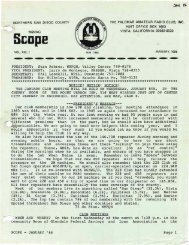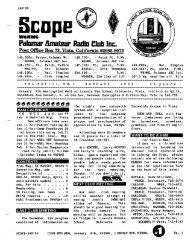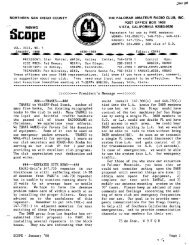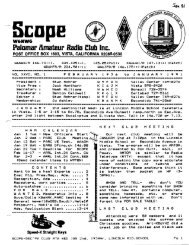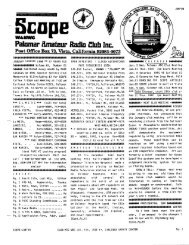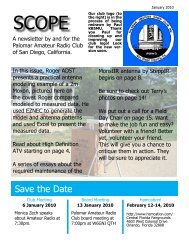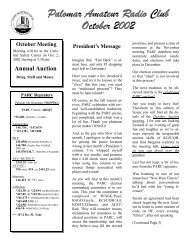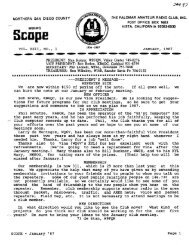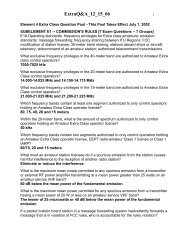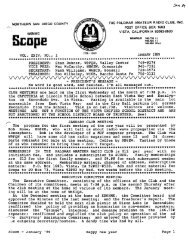You also want an ePaper? Increase the reach of your titles
YUMPU automatically turns print PDFs into web optimized ePapers that Google loves.
e-mail.<br />
If you do not hear a "kerchunk" on<br />
the 449.420 frequency, give 447.200 a<br />
try!<br />
Ham Satellite<br />
<strong>Amateur</strong> <strong>Radio</strong> satellite UO-14 is<br />
now operating as a full duplex voice<br />
repeater. The uplink is 145.975 MHz,<br />
and the downlink is 435.070 MHz. No<br />
more than 5 W is required to make contact<br />
when the satellite is in view. Some<br />
have made the trip with as little as 1.5<br />
W.<br />
bttp:/lwww.arrLorgIarrDetterlOO/021S/<br />
Old Repeaters?<br />
As we all get older we sort of expect<br />
to start falling apart but with our old<br />
Motorola repeaters this does not seem to<br />
be happening.<br />
From time to time we hear some of<br />
our repeater users start to "blame" our<br />
"old repeaters'" for all sorts of things:<br />
pulsation's, growls, thumps, bumps, etc.<br />
But we bet that when you get right<br />
down to it, our repeater users have more<br />
problems with their own rigs and computers<br />
then we do with our repeaters.<br />
The 146.7 packet repeater started out<br />
as our main 146.730 machine and served<br />
that way until it was changed over to<br />
make a packet repeater several years<br />
ago. That Motorola repeater was bought<br />
around 1975 so it has been in continuous<br />
action, day and night, for almost 25<br />
years with very little down time. This<br />
repeater was the only one that the club<br />
bought new.<br />
The rest of the repeaters were made<br />
out of used Motorola mobile units and<br />
they have suffered very little down time.<br />
So here is a status report for 1999<br />
and early <strong>2000</strong>:<br />
1~5.0~: ~otorola, haven't done anythmg<br />
With It for years and it is like the<br />
E~ergizer Bunny ..just keeps going and<br />
gomg<br />
146.700: Motorola, our oldest unit .. a<br />
real bunny<br />
146.730: Motorola, bad patch interface<br />
board repaired<br />
147.075: GE, possible patch problem<br />
~ <br />
147.130: Motorola, sluggish PL reed<br />
relay<br />
449.420: Motorola, appears to have low<br />
power output ..or a bad antenna.<br />
So don't be too quick to criticize our<br />
"old repeaters". The problem could be<br />
old heliax which is being replaced this<br />
year, ant~nna problems, or something<br />
wro~g With your setup ... or just plain<br />
old mtermodulation someplace up on<br />
<strong>Palomar</strong> Mountain.<br />
Generals booted!<br />
FCC says Generals not allowed in<br />
Advanced subbands!<br />
The FCC says newly upgraded General<br />
class licensees may not operate in<br />
the current Advanced class subbands<br />
under the new amateur rules.<br />
Bill Cross, W3TN, of the FCC's<br />
Public Safety and Private Wireless Division<br />
notes that no privileges changed<br />
for any license class.<br />
The Advanced class license continues<br />
to exist under restructuring, which<br />
became effective April 15, although the<br />
FCC no longer accepts applications for<br />
Novice or Advanced class licenses. Current<br />
Generals do not earn Advanced<br />
class privileges until they upgrade to<br />
<strong>Amateur</strong> Extra class, when they earn<br />
both Advanced and Extra privileges.<br />
The FCC also says General class<br />
operators may hold only Group C (Ix3)<br />
or Group D (2x3) call signs, as it was<br />
under the old rules. Generals remain<br />
ineligible to apply for or hold Group B<br />
(2x2) call signs.<br />
Newly upgraded licensees were cautioned<br />
to check the revised Part 97 rules<br />
ca.refully to make sure they're not operatmg<br />
beyond their privileges. FCC Part<br />
97 rules are available on the ARRL<br />
Web site at:<br />
www.arrLorgifieldlregulatioaslDewsipart971<br />
The FCC today released the Errata<br />
to its December 30, 1999, Report and<br />
Order on restructuring. The Errata incorporate<br />
minor errors contained in the<br />
original R&O and already made in the<br />
version ofthe new rules that appeared in<br />
The Federal Register earlier this year.<br />
(passed to us by W6YOO and Tom Lebens from<br />
the ARRL Bulletin -Ed)<br />
Cork<br />
(aplugfor)<br />
Some of our repeater antennas are<br />
made of aluminum tubing and originally<br />
came with plastic caps over the open<br />
parts ofthe tubing.<br />
. Over the years this plastic cap deterIorates<br />
and falls apart exposing the<br />
openings to rain during the winter<br />
~o~ths which then turns to ice swelling<br />
IDSlde the tubing and deforming it or<br />
splitting the tubing.<br />
We ha~e been thinking of plugging<br />
the ends With cork so you wine drinkers,<br />
save those corks or plastic stoppers<br />
.. unl~s you can think ofa better way of<br />
pluggmg these antenna openings.<br />
Frequency?<br />
This may not be news to most of<br />
you, but I thought it was worth passing<br />
along. Was received from Greg,<br />
W A9GYI, who was a fellow MARS<br />
operator and friend in Viet Nam and<br />
California. de N6KI<br />
(N6KlDennis operated at the Barry Goldwater<br />
statio~from 71-74 as a civilian while attending<br />
ASU In Tempe. He handled Air Force MARS<br />
stations only in Vietnam and Laos til war ended<br />
in 73, than handled Philipines and Laos from<br />
7~ to 74. He operated Army Mars stn from<br />
Vietnam 68 - 69. Goldwater was Air Force<br />
MARS so he did not patch thru his station<br />
while in the Army -Ed)<br />
The following article is the first installment<br />
of a new monthly column that<br />
will be appearing on http:www.adiradio.com<br />
What's the FREQUENCY, Kenneth?<br />
By Ken Collier, K06UX<br />
On April 28, <strong>2000</strong> something amazing<br />
is going to happen, something that<br />
could have a profound effect on the<br />
future of amateur radio in the USA for<br />
years to come.<br />
~o, it isn't license restructuring. By<br />
Apnl 28th the dust will have begun to<br />
settle on the license restructuring issue<br />
leaving behind a simplified amateur ra~<br />
dio licen~e structure and the largest<br />
flurry ofbcense upgrades in history.<br />
As exciting as the new license struc<br />
~e is, i~ is overshadowed by the potential<br />
ramifications of April 28th. That's



